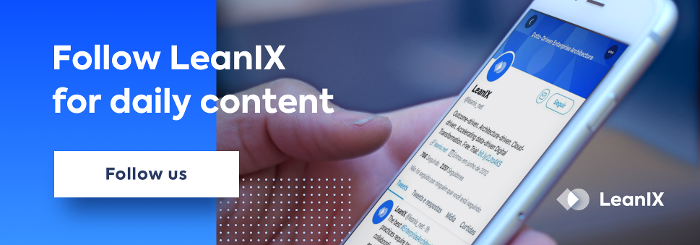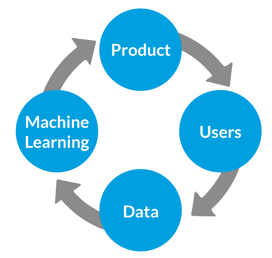
“We are in the early stages of a 10-year cycle which machine learning is morphing from a lab curiosity to a rich, pervasive technology value-add.” - Phillip Harpur, Technology Analyst.
Over 90% of the data in the world today has been created in the last two years alone. The current output of data is roughly 2.5 quintillion bytes a day. As a whole, 49.8% of the population has an internet connection. On average, the US alone spits out 2,657,700 gigabytes of Internet data every minute.
Big data has the potential to make organizations stronger, smarter, and more productive by providing the basis to make impactful, data driven decisions. Organizations that let data fuel their business decisions are more successful.
Previously, business leaders proposed improvement plans and processes gathered from often untested hypotheses, intuition, gut feelings, and trial and error. Enterprise Architects (EA) of the past spent a great deal of time modeling extensive, rigid architecture models.  These models took months to complete and were often created with aged data. More often than not, the situations that the architecture model addressed changed during planning and implementation. During this current age of rapid digital transformation, rigid architectures and obsolete data models have proven to be obsolete. Machine learning algorithms allow business leaders to remove the guesswork from important business decisions. Insights gained from machine learning tasks empower organizations to make smarter predictions by continually learning and adapting their models based on real-time data.
These models took months to complete and were often created with aged data. More often than not, the situations that the architecture model addressed changed during planning and implementation. During this current age of rapid digital transformation, rigid architectures and obsolete data models have proven to be obsolete. Machine learning algorithms allow business leaders to remove the guesswork from important business decisions. Insights gained from machine learning tasks empower organizations to make smarter predictions by continually learning and adapting their models based on real-time data.
In order to bring measurable value to their firms, Enterprise Architects of Tomorrow must understand, utilize, and evangelize the latest technologies driving the industry. These current trends include predictive analytics, deep learning, prescriptive analytics, and machine learning. All of these trends use current data to make predictions about unknown future events.
This series will provide an overview of the approaches to machine learning, the steps to creating an algorithm, and how Enterprise Architects can use the insights generated from machine learning to plan future business decisions. This series will also include recommendations based on LeanIX’s experience with machine learning and outlines steps to prepare your enterprise for machine learning.
What is machine learning?
Machine learning is an application of artificial intelligence that provides systems with the ability to automatically learn and improve from experience without being explicitly programmed. Machine learning focuses on the development of computer programs that can access data and use it to learn for themselves.
The process of learning begins with observations of data, such as examples, direct experience, or instruction, in order to look for patterns in the data and make better decisions in the future based on the examples provided. The primary aim is to allow the computers to learn automatically without human intervention or assistance and adjust decisions accordingly.
Why use machine learning techniques in your enterprise?
“Any sufficiently advanced technology is indistinguishable from magic.” - Clarke’s Third Law
Machine learning technology is not only relevant for internet giants, but also relevant for traditional firms like manufacturing, construction, insurance, finance, and any other industry.
For example, artificial intelligence offers innovative solutions in manufacturing like MAX - a cloud based predictive maintenance service for elevators. MAX collects data such as door movements, trips, car calls, and error codes. This data is sent to the cloud where unique algorithms analyze it for patterns and compute the equipment’s operation and the estimated remaining lifetime of its components. Precise and predictive diagnostics are delivered to technicians in real-time, indicating when and where intervention is required.
Machine learning algorithms affect and benefit your life in many undetectable ways. They currently identify and eliminate spam from your inbox, select images for social media posts, curate content to appear in your social media timelines, monitor your credit score, and help to prevent fraud. 
At LeanIX, we assess the usage of our SaaS product and help customers to optimally benefit from our EA management solution. Amazon uses machine learning algorithms to show you trustworthy reviews, PayPal uses it for transactional fraud detection, hotels benefit from real-time customer-specific strategic pricing, and top marketing firms use machine learning algorithms to gauge customer sentiments.
The connection between enterprise architecture and machine learning:
“The goal is to turn data into information, and information into insight.” – Carly Fiorina, former CEO of Hewlett Packard.
In the 2017 Economist Intelligence Unit report, Artificial Intelligence in the Real World, 75% of more than 200 business executives surveyed said artificial intelligence will be actively implemented in their companies within the next three years.
Our goal at LeanIX is to use current cutting-edge technologies to make Enterprise Architects’ daily tasks easier. Presently, the line from machine learning to constructive EA practices can be ambiguous. However, Enterprise Architects will be required to plan and implement AI-like services in the future, therefore it is imperative to become familiar with the link between EA and AI.
For decades, simple reports of metrics (KPIs) produced enough data to make long-term decisions. Data derived from machine learning has the capacity to gather much deeper insights than simple KPIs. For example - while selecting global standard applications or technology for their teams, Enterprise Architects can use machine learning algorithms to gather and test user-generated data to choose the best application for the enterprise. A machine learning pipeline would query the number of logins on various applications, determine the length of time spent on said applications, gauge user satisfaction, and identify which information is relevant for the decision.
Enterprise Architects will be able to tell which business applications provide the most value to their teams, which apps are redundant, and which apps go unused. Using user-generated data, EAs can select one global standard app for each business capability, shut down the use of redundant apps, and cut IT costs.
Refining user experience
From machine learning tasks, your company can constantly improve your product or service. Identifying at-risk customers early and offering personalized content or customer care to educate them on best practices increases customer satisfaction and retention, and enhances their overall experience with your company.
The virtuous circle of artificial intelligence refers to a complex chain of events that reinforce themselves through a feedback loop. For EAs, the virtuous circle starts with the product. Users generate data while using the product. This data is fed into the machine learning algorithm. The results produced from the machine can be applied to improve the product (see figure 1).
 Figure 1: Virtuous circle of AI: User-generated data helps to continuously improve your product.
Figure 1: Virtuous circle of AI: User-generated data helps to continuously improve your product.
Sign up for our newsletter below for updates on the next installment in the series. If you’d like to read more before then, download our machine learning whitepaper.

![Enterprise Architecture Success Kit [White Paper]: Everything you need for quick time-to-value and long-term success through EA. »](https://no-cache.hubspot.com/cta/default/2570476/17fd5630-69af-4c4c-82f1-8e88da49fc47.png)



